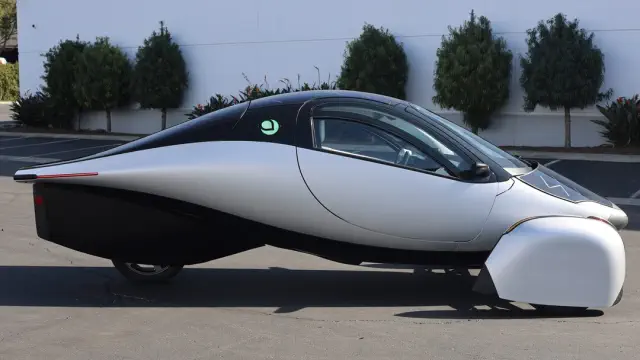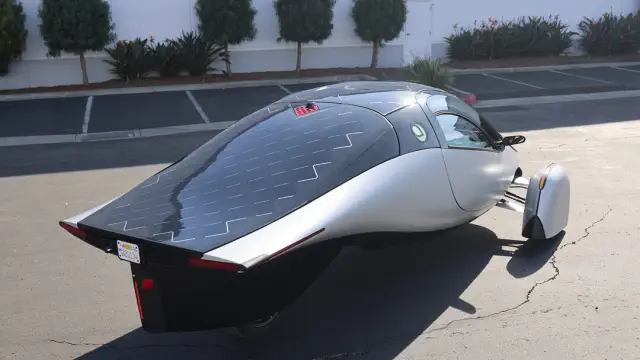Nearly two decades in the making, the otherworldly three-wheel Aptera is headed to production this year as a $40,000, 400-mile EV that can capture up to 40 miles worth of free solar energy every day. Maybe. The California startup made similar promises in 2008, 2009, 2012, and 2022 and yet it has never delivered a single vehicle. Is anything different this time?
In a no-frills booth at CES 2025, Aptera showed off its production-intent design with a new interior and details on the first cars that will hit the road. What started as a 300-mpg hybrid and 120-mile EV in 2007 has evolved into a 400-mile EV while staying true to the original three-wheel, two-passenger teardrop shape that gives the car incredible aerodynamics. Aptera claims an efficiency of 10 miles/kWh, double that of the most efficient car on sale in America today, the Lucid Air EV.

View pictures in App save up to 80% data.
The Launch Edition, priced at approximately $40,000, will feature front-wheel drive powered by a 201-horsepower permanent-magnet motor from Vitesco, which is energized by a 42-kWh lithium-ion battery utilizing LG cells. Aptera has plans to introduce all-wheel-drive options and various models with both larger and smaller battery capacities in the future. Additionally, solar panels integrated into the hood, dashboard, roof, and rear hatch can capture up to 500 watts of electricity in real-world conditions, potentially generating up to 4 kWh on a typical summer day in California. The vehicle can also be charged at a maximum rate of 50 kW via its NACS port.
Ultimately, it all boils down to finances.
Aptera says that it has more than 50,000 reservations and that it has has crowd-funded $140 million from 20,000 individual investors, but it needs more money if it’s going to deliver on its production promise this time. At CES, co-CEO (and one of Aptera’s original founders) Chris Anthony told MotorTrend it will take another $60 million to finish the development work, buy the tooling, and build out the Carlsbad, California, assembly plant. “We’re still in fundraising mode and we hope that we inspire some people in this beautiful building (Las Vegas Convention Center) to invest in Aptera,” Anthony said. “We’re trying to raise $20 million in the first quarter of this year. That will basically kick off all the long-lead items to get into production, but it’s a $60 million plan to get into volume production.”

View pictures in App save up to 80% data.
Anthony mentioned that the company has completed one of its biggest acquisitions to date, which includes the molds for the carbon-fiber sheet-molding composite body structure and the fiberglass sheet-molding composite body panels that will be produced in Italy. The forthcoming $20 million investment will be allocated for the tooling required for the diecast metal suspension arms and the injection-molded interior parts.
A significant amount of engineering tasks are still pending. The company has created four validation prototypes featuring the production body, which will be utilized to complete the suspension tuning and adjust the anti-lock braking system, among other responsibilities. Officially categorized as a motorcycle, Aptera's unique three-wheeled design circumvents many regulations that would typically prevent a small company with just 50 staff members from introducing a vehicle to American highways. The design incorporates two front airbags, and Anthony has stated that Aptera plans to release videos and data from its own crash tests to showcase the vehicle's safety performance.
Exploring Las Vegas on Three Wheels
A quick spin through Las Vegas in one of Aptera's validation prototypes highlighted the paradox of the company's progress toward production – they seem both near and far from reaching that goal. Once you step inside through the gullwing doors, you'll discover an unexpectedly roomy cockpit, boasting 32.5 cubic feet of storage behind the driver and passenger seats. Despite its futuristic exterior, the experience of sitting in the Aptera feels surprisingly conventional when you focus ahead. However, the split side windows and absence of rear glass require the driver to depend on cameras and screens for visibility to the sides and rear.

View pictures in App save up to 80% data.
The engineering car had seats and seatbelts and little else in the way of passenger comforts. Our driver flipped a toggle switch to demonstrate the climate control blower’s hushed whir at full blast, but there were no vents to direct that air toward passengers. Back at the convention hall, a static show car modeled the production-intent interior that’s simpler (and presumably cheaper to build) than what was shown in 2022. Taking cues from Tesla, it features a yoke steering wheel and a central infotainment touchscreen that serves double duty as the instrument cluster. The prototype’s sideview camera mirror displays have been combined into a single screen on the steering column for production.
Weighing in at only 2,200 pounds, the Aptera demonstrated impressive acceleration, despite the constraints imposed by its incomplete software. Reports indicate that the Launch Edition models are anticipated to reach 60 mph in under six seconds. The prototype we experienced lacked power to its steering system, forcing the driver to exert physical effort on the yoke while exiting the parking area. Once on urban roads, the Aptera handled bumps and potholes with ease, although the impacts transmitted into the unfinished interior as loud thuds and clunks.
The Extended Journey to Deployment
While Aptera could feasibly construct cars in a garage setting and declare the commencement of production, their strategy aims for a more ambitious goal: producing up to 80 vehicles daily, as recommended by engineering consultant and YouTuber Sandy Munro, who is both an investor and advisor for Aptera. “He played a crucial role in guiding the design from an initial prototype stage to creating the most manufacturable vehicle possible,” Anthony remarked. The vehicle's framework consists of only six components, and the overall design allows for assembly in a factory environment with just 12 workstations.

View pictures in App save up to 80% data.
However, this extreme simplicity adds complexity to the current task. Alongside the car's development, the small engineering team must also design the machinery required to manufacture it. Anthony envisions the factory increasing its output to 20,000 vehicles annually within nine months of commencing production at the end of 2025.
Before that can happen, Aptera needs to clear the same hurdle that tripped it up in 2011 and sent the company stumbling into liquidation—the money. “We would love one investor to be so inspired by what we’re doing that they just hand us a $60 million check,” Anthony told MotorTrend. “But it could be something that’s kind of piecemeal over the next nine months to get that $60 million into the company.” Are you convinced?